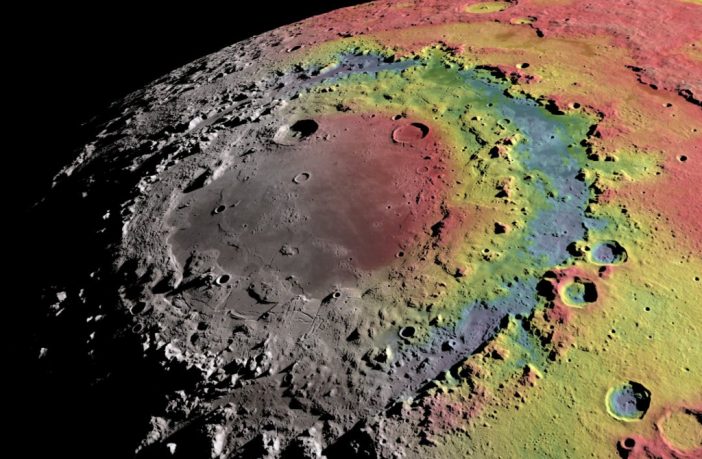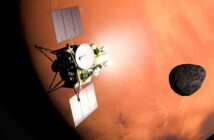Some 3.8 billion years ago, the moon was a dangerous place – constantly bombarded with asteroids and comets. Our celestial neighbour still bears the scars of this time, in the shape of craters. The biggest of these are called basins, and one is the mysterious, 930km-diameter Orientale Basin, which looks like a bull’s eye with three round rings around it.
Scientists have long tried to work out what what happened during the violent event that caused the Orientale Basin, but it’s proven rather difficult. But new data and models from the NASA GRAIL (Gravity Recovery and Interior Laboratory) spacecraft has finally started to unveil the truth. This spacecraft flew just two kilometres above the crater’s surface, giving researchers a chance to look at it with a resolution never achieved before.
The “heavy bombardment” era of the moon actually affected all bodies in the solar system. However, very large impacts were comparatively rare at this time and we therefore have only a few examples to study for details of their formation. The Orientale Basin on the moon is one, and the much smaller Chixculub Impact Crater on Earth is another.
The science of rings
If you want an image of what happens during large impacts and have a full cup of tea nearby, you can do the following experiment. Drip a single drop of tea from a spoon held at some height above the cup into the tea and watch the circular ripples this causes. Then repeat the experiment and watch from the side. Can you spot the “hill” that shoots up at the point of impact? Many things happen too fast to observe with the unaided eye, and high speed cameras would be required to capture the process fully.
However, what can be observed in water is actually very close to what happens if a very large piece of rock slams into a rocky planet – or the moon’s surface – at high velocity. First, it hits the surface, causing a compression wave, which goes downwards into the surface until the kinetic energy is insufficient to push any further down. During this process, a circular depression is created – the so-called “transient cavity”. This is dependent on impact size, velocity and the material properties of the target. Since the material properties of the target are known, the diameter of the transient cavity allows us to understand what actually happened, and calculate the impact size and the volume of the displaced material.
The waves released by the built-up pressure then begin to diffuse, and the central part of the cavity will bounce back up. Finally, gravity will cause the over-steepened walls of the transient cavity to slump inwards, forming characteristic terraces. In liquids, the movements will finally level all traces of a crater, but in rocks the movements will stop before all traces are levelled out, leaving a crater or an impact basin behind.
Solving the puzzle
So how can we apply all this to the Orientale Basin? Since one key piece of information is the diameter of the transient cavity, the central question for studies of the basin was always which of the rings – if any – is equivalent to the transient cavity?

Gregory H. Revera photographer, cropped and marked by User:Thincat, CC BY-SA
The new study, which modelled the impact based on the data from GRAIL, found that none of the rings visible at the surface correlates directly to the transient cavity’s diameter. Instead, the transient cavity’s diameter, which was never preserved, can be estimated to be between 320 and 460km. This is larger than Orientale’s “inner depression” but smaller than the diameter of the inner ring. With that, the team estimates the displaced rock volume to be about 3.4 x 106 cubic kilometres.
We cannot even imagine the magnitude of this event by comparing it with man-made structures. Take the volume of one of the top ten largest buildings in the world: the London O2 arena, which has a diameter of 365 metres and is 100 metres tall. If we calculate the volume of the arena simply from the diameter and the height of the towers, then the equivalent volume of about 324m O2 arenas was displaced by the impact that formed the Orientale Basin.
In a second study, researchers manged to simulate the actual impacting body, finding it would have been a 64km diameter body travelling at 15km per second. This is faster than the Apollo rocket that carried astronauts off the Earth and to the moon – that travelled at a speed of just over 11km per second.
The new results are very exciting as they could help researchers better understand the formation of the multi-ring basins on the moon, Earth and other planets. This could help us crack the earliest history of the Earth – the time of the late heavy bombardment. This era – about 3.8 billion years ago – is also around the time we find the earliest traces of life on Earth. Therefore, understanding this early history of the inner solar system better will help us grasp what conditions life faced at the time.
Susanne Schwenzer, Lecturer in Earth Sciences, The Open University
This article was originally published on The Conversation. Read the original article.



